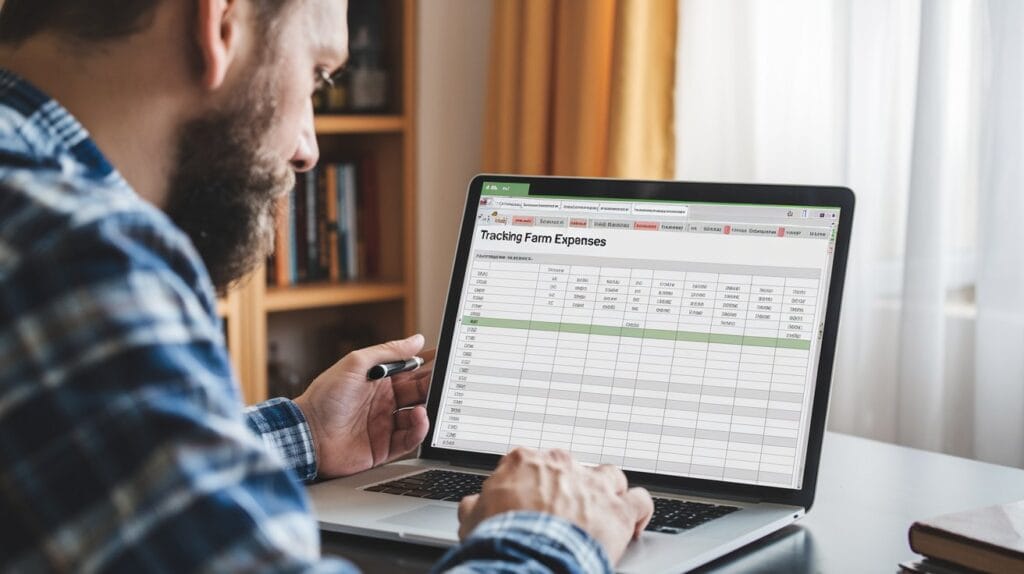Essential Tools for Tracking Farm Expenses
Overview of Spreadsheet Use
If you’re looking to manage your farm finances effectively, utilizing spreadsheets can be an excellent starting point. A well-structured spreadsheet is a dependable tool for tracking farm expenses, providing an organized layout where you can input various cost categories. You can create a customized template that reflects the unique aspects of your farm, allowing you to document expenses such as seeds, fertilizers, equipment maintenance, and labor costs.
Read More: Best Medical Expense Tracking Software to Manage Your Budget
Using software like Excel or Google Sheets, you can set up formulas to automatically calculate totals and even perform basic analytics.
Furthermore, spreadsheets are flexible; you can update them in real time as expenses arise.
However, as your farm operations grow, relying on spreadsheets alone can become cumbersome and less efficient.
Benefits of Farm Management Software
While spreadsheets are useful, farm management software offers features that streamline farm expense tracking beyond basic record keeping. Advanced software solutions, like AGRIVI and Farmbrite, can integrate various functionalities to manage not only expenses but also inventory, harvest data, and labor costs.
Adopting dedicated farm accounting software allows for real-time data entry and analysis, offering insights that help you manage cash flow effectively. These applications can categorize and track ongoing expenses automatically, thereby reducing manual workload.
Moreover, they often provide reports that highlight spending trends, essential for making informed financial decisions.

Popular Farm Finance Apps
Several apps stand out in the domain of agricultural bookkeeping. QuickBooks is a popular choice due to its user-friendly interface and efficient bookkeeping capabilities. It can help you seamlessly track income and expenses related to your farm operations. Other notable apps, such as Expensify and Agrivi, also contribute to effective financial management, enabling you to capture receipts and manage expenses on the go.
Researching the best apps for tracking farm expenses based on your specific needs can help you select the right combination that suits your operation. Many of these tools are designed for ease of use, providing excellent support for all farming activities.
Understanding Farm Expenses
Types of Farm Expenses
Your farm expenses can be categorized into several types, and understanding them is vital for effective expense tracking. Expenses generally fall into two significant categories: fixed costs and variable costs. Fixed costs include things like insurance, property taxes, and loans. These costs tend to remain constant regardless of operation size, providing a predictable expenditure pattern.
In contrast, variable costs fluctuate based on production levels and are influenced by market prices. These expenses often include seeds, fertilizers, fuel, and labor. Knowing how to distinguish between these two types of expenses can enhance your farm expense tracking efforts.
Fixed vs. Variable Costs
It’s crucial for you to manage fixed and variable costs distinctly. Fixed costs require long-term strategic planning, enabling you to budget consistently.
On the other hand, variable costs require more dynamic tracking due to their variability; they can shift dramatically from year to year based on crop yields and market conditions.
For example, if you run a dairy farm, the fixed costs involve mortgage payments on your barn, while variable costs may encompass feed and veterinary bills that vary according to production levels. Monitoring both types of costs aids in maintaining a healthy cash flow.
Common Expense Categories
When organizing farm costs, certain categories will typically emerge. Some common expense categories include:
Production Costs: Seeds, fertilizers, feed, and pest control.
- Equipment Costs: Maintenance, fuel, and depreciation of machinery.
- Labor Costs: Salaries, benefits, and temporary labor for harvest.
- Operational Costs: Utilities such as water, electricity, and internet.
- Insurance and Taxes: Property, equipment insurance, and local property taxes.
By knowing how to categorize these expenses accurately, you enhance your ability to track farm costs and identify areas for potential savings.

Creating an Effective Budget
Steps for Expense Tracking
Creating a comprehensive budget is foundational for successful farm expense tracking. Start by gathering all relevant financial data, including past expense reports, receipts, and invoices. Use this data to forecast future spending across all categories.
It’s essential to regularly input new expenses into your farm management software or spreadsheets, categorizing them as they arise. This practice allows you to keep an up-to-date understanding of your financial state.
Integrating Apps and Software
Choosing the right combination of tools for tracking your farm expenses is critical. Many farmers opt for a combination of spreadsheet utilization for immediate tracking and farm accounting software for longer-term budget management. Integrating these tools ensures that you can regularly update your financial records while also analyzing them for growth opportunities.
Additionally, many farm management applications can sync with your bank accounts, automatically capturing expenses and saving you from time-consuming manual entry.
Importance of Regular Updates
Regularly updating your records is vital for maintaining an accurate financial picture. Schedule weekly or monthly reviews of your farm expenses to capture all costs in real time. This consistency offers a deeper understanding of spend patterns and allows you to adjust your budgets as needed.
Establishing a routine can help identify excessive spending or areas where you can cut costs, ultimately benefiting your farm’s bottom line.
Tips for Smarter Farm Budgeting
Analyzing Spending Patterns
Frequent analysis of your farm’s spending patterns can yield valuable insights. Utilize the reporting features of your chosen tools to identify trends, such as seasonal increases in specific costs (e.g., fertilizer during planting season). Recognizing these patterns enables you to forecast more accurately and adjust budgets accordingly.
Leveraging Financial Reports
Most farm management software provides features to craft detailed financial reports. Leverage these reports to glean insights into profit margins, operating costs, and overall farm performance. Setting aside time to interpret these reports will help inform future decisions and budget adjustments.
Adjusting Budgets Seasonally
The nature of farming is deeply influenced by seasonal changes.
Therefore, adjusting your budget to reflect these seasonal variations can enhance your financial planning. Anticipate expenses tied to planting and harvest seasons, allowing you to allocate funds appropriately. Being proactive in budgeting seasonally ensures you are prepared for fluctuating costs throughout the year.

FAQs
How can I track my farm expenses effectively?
Tracking your farm expenses effectively involves utilizing a combination of accounting methodologies. Start with an organized spreadsheet for day-to-day entries, then consider integrating a farm accounting software that consolidates this data for comprehensive insights.
What tools are best for expense management?
The best tools for expense management include farm management software like AGRIVI, QuickBooks, and dedicated apps such as Expensify. These tools can automate many aspects of farm expense tracking while providing detailed analytics.
How do I organize receipts for tax purposes?
To organize receipts for tax purposes, categorize them by type of expense and maintain a digital record with software like Shoeboxed, which can scan and store receipts automatically. Always keep copies for your records.
What are tips for categorizing farm costs?
Categorizing farm costs involves defining all possible expense categories relevant to your operation, such as production, equipment, labor, and operational costs. Use your accounting software to create clear categories and stick to them consistently.
How do you keep track of farm expenses?
Keeping track of farm expenses can be accomplished through a combination of daily logging in spreadsheets and utilizing farm management software for comprehensive oversight of your overall financial health.
What is the 5-year rule for farm losses?
The 5-year rule states that if a farm business incurs a loss in three consecutive years, the IRS may classify it as a hobby rather than a legitimate business, affecting tax deductions. Maintaining solid records and a clear profit motive is essential.
How do I write off my small farm expenses?
You can write off small farm expenses by documenting all qualifying expenditures and reporting them accurately during tax season. Utilizing IRS Schedule F can help clarify which operational costs can be deducted.
How many acres is considered a farm for taxes?
The IRS does not specify a minimum number of acres for tax purposes. However, factors like gross income and the nature of the operations can help determine whether a parcel qualifies as a farm.
Can you claim a hobby farm on taxes?
If your hobby farm generates income and meets certain IRS conditions, you might be able to claim it for tax purposes, though it may not have the same benefits as a fully operating farm. Consult a tax professional for guidance.



